1. Introduction
The shielding of the HTS core remains a key component in any possible spherical tokamak fusion power plant. An optimal shielding material needs to reduce the incoming heat load to the HTS core, and to reduce its neutron and gamma radiation damage. It must also be itself resistant to radiation damage, be able to withstand high temperatures, retain adequate isotopic content and remain stable over many years of operation. It must be capable of manufacture in the tonnage quantities necessary for a fusion power plant. In an earlier paper [1] candidate shielding materials containing tungsten and boron were evaluated using the Monte Carlo modelling code MCNP [2]. It confirmed that the inclusion of boron within a tungsten-based shield is advantageous, because of its high neutron absorption cross section at lower energies. It found W2B5 to be particularly effective, with its favourable structure, density, and high atomic number densities. Hydride shields have been shown to be highly effective. ZrH2 and the borohydride Zr(BH4)4 gave neutron half-attenuation distances of order 50 mm [3] comparable with those reported for tungsten borides [1], although greater than the 40 mm reported for W2B5. Gamma shielding of the heavy metal hydrides BaH2 and ZrH2 have been examined [4]. Their gamma half-attenuation distances suggested them as highly effective gamma shielding materials.
Activation and transmutation product formation under fusion neutron irradiation has been reported for several candidate fusion engineering materials [5], particularly in the case of W and W alloys [6]. The activation behaviour of tungsten under neutron irradiation is complex. H and He production is relatively minor, however significant quantities of Re, Ta, and Os will be produced. These elements cause Re and Os-rich clusters and precipitates, leading to material embrittlement [7].
Quantitative assessment of activation product data for the tungsten carbides and borides is yet to be reported. Oliver et al [8] proposed that in WC, Re, Ta, and Os production would likely lead to the precipitation of secondary carbides, particularly TaC. Neutron irradiation studies of slightly porous coarse-grained W2B5 have led to swelling, embrittlement, and eventual fracture due to helium production [9]. Although the material performed well compared to the other candidate borides based on metals in groups IV-VI (Ti, Zr, Hf, V, Nb, Cr and Mo). Activation product release of He and Li and 10B burn-up have been characterised in neutron irradiated group IV-V metal borides [10], although this study excluded any tungsten borides. Isotopic tailoring of 11B may be necessary if borides are to be used as structural materials [11]. The activation of the core materials including the HTS tapes, their insulation, copper matrix and inconel structure will be discussed in a later paper.
In this study the code FISPACT-II v4.0 [12, 13] is used to study the activation, decay cooling, gas production, and displacements per atom (dpa) of these materials over 30-year operations at 200 MW fusion power, followed by a 10-year cooling-off period. Section 2 describes details of the FISPACT-II calculations used. Section 3 details the shield material activation during operations and radioactive decay during a 10-year cooling-off period. The gamma-ray energy spectrum from the irradiated materials is discussed in section 4. Gaseous transmutation products are concerning because of possible swelling and bubble formation and are considered in section 5. The 10B isotope is necessarily depleted during neutron absorption through the shield and these effects are detailed in section 6. The results of FISPACT-II estimates of radiation damage in terms of dpa are examined in section 7.
2. Computational details
Monolithic shields were chosen along with shields consisting of 6 layers with water cooling between each layer. For each material the tokamak major radius was varied in 5 steps from 1400 to 2200 mm. For each boride material, the 10B isotopic concentration was varied in 6 steps from 0% to 100%. Five positions across the shield from the plasma-facing side to the HTS-facing side were considered. This gave a total of (5x6+2)x5x2x5=1600 FISPACT-II runs which are summarised in the Supplementary Material. Activation computations were made for a constant plasma fusion power of 200 MW, detailed each year up to 30 years. A period of 10 years after shutdown was considered with FISPACT-II solver outputs at 1 hour, 1 day, 1 week, 1 month, 6 months, 1, 2, 3, 4, 5 and 10 years. Fluxes were calculated in cells extending vertically ± 200 mm from the reactor mid-plane, where neutron production is concentrated. From the resulting FISPACT-II outputs the following were extracted:
3. Activation of the shield material
It is helpful to start with a monolithic tungsten shield in order to separate its activation from those of the borides. Figure 1 shows the rise in activation of monolithic tungsten over the 30 years of operating on a linear time scale, followed by its cooling off for 10 years on a logarithmic scale. Activation is plotted only for isotopes with an activity within 10-4 of that of the most active isotope. The decay results are qualitatively consistent with reported activation decay data for all the elements under ITER fusion spectra reported by Gilbert et al [14].
After the first year of operation the isotopes of most importance for tungsten are 185W, 181W, 187W, 183mW and 185mW. During operations the isotopes 186Re, 188Re and 182Ta are created by transmutation in significant quantities. 186Re rises to become the isotope with the second strongest activity. During the 10-year cooling period 185W and 181W are dominant for the first year while the initially important 186Re decays within the first month of cooling. After 2 years there is little activity. The limits for disposal as very low-level radioactive waste are dealt with in the Government Department for Environment, Food and Rural Affairs guidance document [15]. Strictly each isotope must be considered individually but for the present purpose the low quantity guidance of 0.4 MBq per 0.1m3 "dustbin" volume will be used, as indicated by the leaf-green horizontal dotted lines in figures 1 to 4.
Figure 2 shows that the boron included in the monolithic W2B5 shield gives generally only around half the activation, caused largely by the lower tungsten atomic density in W2B5 compared to W. It does introduce 8Li as a significant immediate activation product, while tritium 3H is important in the cooling period, where it becomes dominant after about a year. It is noticeable that the actual activation for the W2B5 after 30 years of operations is 4005 MBq/tonne, which is appreciably less than the 10120 MBq/tonne for monolithic tungsten, despite it being a much better shield. This could be a considerable advantage in the case of a loss-of-coolant event.
Figure 1.
Figure 2.
Figure 3. Figure 3 compares the activation of all candidate materials after 30 years of operation. The borocarbide B0.329C0.074Cr0.024Fe0.274W0.299 shield contains a considerable fraction of iron and chromium and soon builds up 55Fe and 54Mn isotopes which give the material higher activation at 1400 mm radius than all the other materials considered. Since tungsten itself activates strongly, it is not surprising that the activation generally decreases with boron atomic fraction, but the decrease is not large at the plasma-facing side, because the neutron fluences there are similar. However further into the shield at lower (and more varied) fluences, the activation depends more strongly on the boron content. The fluence was shown in figure 6 of [1] to depend on boron atomic fraction very much like the activation dependence seen here.
The dashed lines in figure 3 refer to shields containing layers of water for moderation and for cooling, as illustrated in figure 3 of [1]. It is seen that the differences are rather marginal in this case as might be expected from the minor changes in neutron fluence across the shield illustrated in figure 13 of [1]. For the remainder of this paper the effects of water channels will be mentioned only when the differences are noteworthy.
Of importance for decommissioning costs is the activation remaining after a cooling-off period of for example 1 year as shown in figure 4. Except for being an order of magnitude lower, the 1-year cooling activation is remarkably similar to the 30-year operations activation of figure 3, depending mainly on the medium lifetime tungsten isotopes. The dependence on boron fraction is much weaker as the activation is dominated by tungsten. After cooling for periods greater than 5 years the situation is different. The tungsten activity is very much reduced, and as shown in figure 2 for W2B5, the boron fraction introduces 3H as an additional longer-lived isotope and the activity after 5 years in only modestly reduced further.
In figure 4 the activation is plotted as a function of distance into the shield. For the boride materials the decay is close to exponential except near the HTS-facing surface. For W and WC shields there is more curvature in these plots. Exponential fits to this region are shown dashed with the half attenuation distances listed for each material in the legend.
While the activation on the plasma-facing surface is similar for all materials with the exception of the borocarbide, the rate of attenuation through the shield varies considerably. W2B5 gives the best attenuation with a half-distance attenuation of 36 mm. The other materials have the attenuation half-distances shown in the caption of figure 4.
Figure 4. 4. The gamma energy spectrum from the irradiation products
FISPACT-II calculates the energy spectrum of the gamma rays created per unit volume and unit time from the irradiation products. In the present computations the spectrum covered energies between 0.01 and 10 MeV. Figure 5 (left) shows the gamma energy spectrum from activated isotopes for the different materials considered after irradiation for 30 years. The dependence on material can be seen most notably by the marked increase in the spectrum above 2.5 MeV for boride materials, which increases steadily with boron content. In contrast the spectrum in the range 0.05-1 MeV decreases slightly with boron content, suggesting that emission processes in this range are dominated by tungsten. The spectrum from all the shield materials differs little during the 30 years of irradiation and is therefore not shown.
Figure 5. The centre section of figure 5 shows for a W2B5 shield the marked decrease of around two orders of magnitude in activation with distance T into the shield from the plasma-facing to the HTS-facing side. The right section shows the decrease during the 10-year cooling-off period after the 30-year irradiation. There is a drop in activation of at least four orders of magnitude by 10 years, depending on the gamma ray energy. In the first half year there is a drop of around 10 over energies 0.1-2 MeV, but the boron-related activity in the energy range from 2 to 10 MeV drops largely away in this time.
5. The production of gaseous irradiation products
The mechanical and thermal properties of any shield material are likely to be adversely affected by any insoluble gaseous products, which might diffuse to form gas bubbles. This can occur whether the gaseous isotopes produced by irradiation are active or not. The FISPACT-II code was used to identify any such isotopes. For all the shield materials considered, the gaseous isotopes detected in significant quantities included: ordinary hydrogen 1H, deuterium 2H, tritium 3H, helium-3 3He, and the alpha particle helium-4 4He.
Figure 6 illustrates the production of gaseous nuclei for monolithic W, WC and W2B5, and their decay during the 10 years cool-down. It is seen that with monolithic tungsten the only significant gaseous isotopes are the stable hydrogen, 4He and deuterium. For WC there is appreciable production of alpha particles 4He, while the production of hydrogen 1H and deuterium 2H is similar.
When boron is present, as with W2B5, the production of gaseous 4He is increased by another order of magnitude, and the production of 1H and 2H is considerably larger, along with the introduction of 3H and 3He in appreciable quantities. Looking at years 30 to 40, during the 10-year cooling-off period, there is no change in the stable gaseous isotopes, apart from the decay of tritium producing a small increase in 3He.
Figure 6. The production of gaseous nuclei as a function of material boron content is summarised in figure 7 for the plasma-facing shields (left) and for the inner HTS-facing shields (right). Note that the two figures are on the same scale. For tungsten shields the production of gaseous nuclei is around a factor 100 lower on the HTS-facing side than on the plasma-facing side. Regarding the boride shields, the reduction factor is around 10. For the boride shields, the gaseous production is seen to be dominated by 4He with the production of other particles being around two orders of magnitude lower. The plasma-facing production of 4He, 1H, 2H, 3H and 3He are all seen to increase slightly with boron content, while the HTS-facing production of 4He decreases up to W2B5 where is forms a local minimum, presumably due to W2B5's superior shielding efficiency. Overall, the gaseous production rate throughout all the boride shields is significantly greater than for tungsten. In this case W2B5 has no substantial advantage over other borides.
Figure 7. 6. The depletion of the 10B isotope during fusion operations
In the boron-containing shield materials considered in this study, the desirable neutron capture by the 10B isotope means that the amount of 10B within the shield material gradually diminishes during operations. The degree of retention has been evaluated using the FISPACT-II code for all relevant materials as a function of time at 5 positions within the shield. Figure 8 illustrates the retention in the concentration of 10B isotope within a W2B5 shield at the 5 positions within the shield on a logarithmic plot. The constant slope shows that the retention is close to exponential with the half-intensity decrease time shown inset.
Figure 8.
Figure 9. The results for R0=2200 mm (right of figure 9) show slightly greater 10B retention on the plasma-facing side. The big difference is that the retention fraction of this isotope increases with depth into the shield at a similar rate, so that it becomes almost totally retained for all materials just half-way into the thicker shield. For thick shields, the results suggest that only the first few layers undergo significant operational depletion, particularly for W2B5. This may mean that only these most exposed layers require replacement or reconfiguration through life. Note that the retention fraction is generally more favourable for the W2B5 shield than for all other materials considered in this study.
The dashed lines in figure 9 show the corresponding values for shields containing 5 layers of water occupying roughly 1/5 of the shield total thickness as detailed in [1]. These have a role in cooling the shield but also in moderating the neutrons. The figure shows that including the water layers has an appreciable effect on the 10B retention factor. At a 2200 mm major radius, the plasma-facing fraction tends to decrease, considerably so for W2B, but then improves more rapidly with distance into the shield soon becoming better than that for monolithic shields. This effect is of practical importance in reducing the operational time before replacement of the plasma-facing layer of the shield due to an unacceptable reduction in the 10B retention fraction.
An increased isotopic concentration of 10B has long been used within the nuclear industry to improve the performance of neutron absorbing control rods and neutron counters [16]. Because of the 10% difference in nuclear mass between the two isotopes, and the relatively large (20%) natural abundance of the 10B isotope, the concentration can be increased relatively easily for example by gas diffusion [17]. It is available commercially [18]. The improved retention of the 10B isotope over 30 years of operations is shown in figure 10 for W2B5 shields with major radii of 1400 and 2200 mm. There is some statistical uncertainty, particularly in the plasma-facing layer, but at all depths in the shield and at both radii, there is a general improvement in isotope retention with 10B concentration. The majority of the possible improvement is achieved by 40% isotopic concentration. It is judged that, because of the rapid increase in retention fraction through the shield, its neutronic performance is unlikely to be appreciably changed. The effects of water-cooling layers in the retention factor are shown by the dashed lines and open symbols. Its effect is again seen to decrease the retention factor.
Figure 10. 7. FISPACT-II estimates of radiation displacement damage to the shield
It has been long known that the fast neutron fluences from fusion give rise to extreme levels of radiation damage in materials. Plasma facing materials in a fusion power plant can experience around 100 displacements per atom (dpa) during the lifetime [19]. These lead to formation of point defects and dislocation loops, eventually clustering into voids, which degrade the material properties. Since fusion energies are much higher than atomic displacement energies Ed ~ 25 eV the resulting cascade of damage centres can extend over multiple sites. These are best studied by molecular dynamics computations where assumed inter-atomic potentials are used to investigate the nature of the cascades [20]. In the absence of these detailed computations, FISPACT-II has been used to provide a "useful integral quantity that allows approximate assessment of the respective damage doses experienced by materials under different neutron fields. This has been shown to correlate well with certain experimental trends" quoting from [21] where FISPACT-II was used to investigate dpa in the DEMO reactor.
The definition of dpa is given in the page 125 of the FISPACT-II manual [13] as
Here ed is the dpa efficiency factor and is set to 80%, φ is the neutron fluence as determined by MCNP, Ni is the number of atoms of type i=1,Nn, dl bar is the dpa reaction cross section and Ed is the displacement energy of each
atom as given in table 9 on page 126 of [13]. Figure 11 shows for W2B5 shields of major radii 1400 mm and 2200 mm, the FISPACT-II cumulative dpa values for the fluxes at the plasma-facing side of the shield. The dpa is divided into the component from elastic scattering processes, from inelastic processes and from capture or disappearance processes when the particle is lost. All the plots are seen to be very close to linear in irradiation time, so that further discussion will be limited to the 30-year dpa values.
Figure 11 The reduction of the total dpa at 30 years through the layers of the shield for all the major radii is described in figure 12. It is seen that for the 1400 mm device, the dpa values are some 40 times higher on the outer surface than on the inner surface, while for the 2200 mm device, the factor is about 105. The dashed line is a simple exponential of the form
exp(-loge(2) T/Thalf) where T is the distance of the FISPACT-II point into the shield and Thalf is a half attenuation distance of 37 mm which was close to the attenuation used in figure 7 of [1] for the attenuation of neutron fluence. The dpa reduction half distance is largely independent of major radius.
Figure 12. The dependence of the dpa as a function of distance into the shield for the various shield materials is shown in figure 13. Except for the position nearest to the HTS core, the variation with distance into the shield is close to exponential as shown by the dashed lines. The slope of each line enables an average dpa to be calculated for the complete shield. On the plasma-facing surface the dpa are naturally higher, and there is an upward trend with boron atomic content. Further into the shield the dpa reduce and the dependence on material boron content becomes more significant and negative, following the neutron flux dependences on boron atomic content shown in figure 7 of [1].
Figure 13. As illustrated in figure 10, there is also the opportunity to use enhanced concentrations of the neutron absorbing isotope 10B. In figure 14 the dpa are shown for all the materials as a function of the 10B isotopic concentration in each boride material. The W and WC values are shown as a reference on the left. The general increase in dpa with boron content noted in figure 11 is matched by a strong 10B isotopic concentration dependence. There is an almost linear increase of dpa with boron content whose slope is greatest at 0% 10B isotopic concentration and decreases with increasing 10B isotopic content. W2B5 appears anomalous in that the 100% concentration gives a rather larger dpa than the 80%. The presence of water layers in the shield has only a marginal effect.
Figure 14. 6. Conclusions The activation and damage characteristics of several tungsten boride materials subjected to 30 years of operations at 200 MW followed by 10 years of cooling off have been examined and compared with conventional tungsten and tungsten carbide shields.
The boride shields activate less than pure tungsten or tungsten carbide. In particular W2B5 activates least of all the materials considered at positions in the shield away from the plasma-facing surface. This remains true after one year of cooling off, although after 5 years cooling the slow decay of the tritium produced becomes the dominant activation product, so that pure W has lower activity than W2B5 after that time.
Gaseous nuclei, particularly 4He, 3H (tritium), 3He, 2H (deuterium) and 1H (hydrogen) are produced in appreciably greater quantities by the boride shields, than is the case for W or WC. This could be detrimental for thermal and mechanical properties and in the case of helium could lead to swelling. The general increase with boron content means that W2B5 has no advantage in this respect. This highlights the importance of future work to develop strategies to manage the helium inventory and mitigate swelling of the material.
10B has a large absorption cross section which is clearly key to its good neutronics performance in shields. Every neutron absorption produces 4He and 7Li so that the fraction of 10B in the shield decreases during operations. The retained fraction is shown to be never less than 70% during 30 years of operations for W2B5. The material performs better in this respect than any of the other borides considered. The rapid increase in retained fraction with distance into the shield from the plasma-facing surface means that the overall depletion of 10B is very small. The presence of water layers in the shield generally decreases the retained fraction of 10B.
Displacements per atom (dpa totals) calculated using the FISPACT-II code were found to be comparable to those for W or WC and decrease rapidly into the shield with at half attenuation distance of order 50 mm. The dpa generally increase with boron atomic fraction in the plasma-facing side of the shield but decrease with 10B isotopic content. The dpa for W2B5 shields are among the lowest of the borides because of the lower neutron fluxes in this material; this suggests that if the expected swelling of W2B5 can be mitigated then the longevity of the material with enriched 10B may be increased since the increased neutron capture macroscopic cross-section reduces the neutron flux, which in turn reduces the dpa.
References [1] Windsor C G, Astbury J O, Davidson J J, McFadzean C J R, Morgan J G, Wilson C and Humphry-Baker S A 2021 Tungsten boride shields in a spherical tokamak fusion power plant Nucl. Fusion 61 086018 https://doi.org/10.1088/1741-4326/ac09ce
[2] Werner C J et al 2018 MCNP Version 6.2 Release Notes Los Alamos National Laboratory Report LA-UR-18-20808 https://permalink.lanl.gov/object/tr?what=info:lanl-repo/lareport/LA-UR-18-20808
[3] Hayashi T, Tobita K, Nakamori Y and Orimo S 2009 Advanced neutron shielding material using zirconium borohydride and zirconium hydride Journal of Nuclear Materials 386-388 119-121
https://doi.org/10.1016/j.jnucmat.2008.12.073
[4] Vishwanath P S and Badiger N M 2014 Effective atomic weight, effective atomic numbers and effective
electron densities of hydride and borohydride metals for fusion reactor shielding J Fusion Energy 33 386-392
https://doi.org/10.1007/s10894-014-9679-4
[5] Gilbert M R, Dudarev S L, Nguyen-Manh D, Zheng S, Packer LW and Sublet J -Ch 2013 Neutron-induced dpa, transmutations, gas production, and helium embrittlement of fusion materials J Nuclear Materials 442 S755-S760 https://doi.org/10.1016/j.jnucmat.2013.03.085
[6] Gilbert M R and Sublet J -Ch 2011 Neutron-induced transmutation effects in W and W-alloys in a fusion environment Nucl. Fusion 51 043005 https://doi.org/10.1088/0029-5515/51/4/043005
[7] Garrison L M, Katoh Y and KiranKumar N A P 2019 Mechanical properties of single-crystal tungsten irradiated in a mixed spectrum fission reactor J Nuclear Materials 518 208-225 https://doi.org/10.1016/j.jnucmat.2019.02.050
[8] Oliver S X, Jackson M L and Burr P A 2020 Radiation-induced evolution of tungsten carbide in fusion reactors: accommodation of defect clusters and transmutation elements ACS Appl. Energy Mater. 3 1 868-878 https://doi.org/10.1021/acsaem.9b01990
[9] Grinik E U, Ogorodnikov V V and Krainy A G 1996 Fracturing of borides under neutron irradiation J. Nuclear Materials 233-237 1349-1354 https://doi.org/10.1016/S0022-3115(96)00293-0
[10] Hoyt E W and Zimmerman D L 1962 Radiation effects in borides, part I - helium release and swelling in irradiated borides US Atomic Energy Commission report GEAP-3743(Pt. I) HREF="https://doi.org/10.2172/1098140
[11] Bhattacharya A, Parish C M, Koyanagi T, Petrie C M, King D, Hilmas G, Fahrenholtz W G, Zinkle S J and Katoh Y 2019 Nano-scale microstructure damage by neutron irradiations in a novel Boron-11 enriched TiB2 ultra-high temperature ceramic Acta Materialia 165 26-39
https://doi.org/10.1016/j.actamat.2018.11.030
[12] Sublet J-Ch, Eastwood J W, Morgan J G, Gilbert M R, Fleming M and Arter W 2017 FISPACT-II: an advanced simulation system for activation, transmutation and material modelling Nuclear Data Sheets 139 77-137 https://doi.org/10.1016/j.nds.2017.01.002
[13] Fleming M, Stainer T and Gilbert M (Ed.) 2018 The FISPACT-II User Manual UKAEA Report UKAEA-R(18)001 https://fispact.ukaea.uk/_documentation/UKAEA-R18001.pdf
[14] Gilbert M R, Sublet J-Ch and Turner A 2016 Handbook of activation, transmutation, and radiation damage properties of the elements and of ITER materials simulated using FISPACT-II & TENDL-2015; ITER FW armour focus. Report CCFE-R(16)37 https://fispact.ukaea.uk/wp-content/uploads/2016/10/CCFE-R1637.pdf
[15] DEFRA Report 2018 Scope of exemptions from the radioactive substances legislation guidance document https://assets.publishing.service.gov.uk/government/uploads/system/uploads/attachment_data/file/731733/RSL_Guidance_update_BEIS_format_v5_180803.pdf
[16] Potapov S P 1962 Application of stable boron isotopes The Soviet Journal of Atomic Energy 10 234-241 https://doi.org/10.1007/BF01846087
[17] Wang Y B, Pei G, Jiang D J and Zhou M S 2020 Economic estimation of boron isotope production by gas diffusion method using BF3 as processing gas J. Phys.: Conf. Ser. 1696 01200 https://doi.org/10.1088/1742-6596/1696/1/012006
[18] American Elements 2021 Boron-10 Isotope, Los Angeles, CA90024 USA https://www.americanelements.com/boron-10-isotope-14798-12-0
[19] Humphry-Baker S A and Smith G D W 2018 Shielding materials in the compact spherical tokamak Phil. Trans. R. Soc. A 377 20170443 https://doi.org/10.1098/rsta.2017.0443
[20] Nordlund K et al 2018 Primary radiation damage: a review of current understanding and models J Nuclear Materials 512 450-479 https://doi.org/10.1016/j.jnucmat.2018.10.027
[21] Federici G, Biel W, Gilbert M R, Kemp R and Taylor N 2017 European DEMO design strategy and consequences for materials Nucl. Fusion 57 092002 https://doi.org/10.1088/1741-4326/57/9/092002
*
(i) the major isotopes causing activation with health and decommissioning consequences
(ii) the gaseous isotopes 1H, 2H, 3H, 3He and 4He which might affect thermal and mechanical properties
(iii) the 10B isotope concentration for examining the operational loss of this neutron absorbing isotope
(iv) FISPACT-II dpa estimates of damage
(v) the gamma energy spectrum of the activation at 13 energies from 0.01 to 10 MeV.
The presence of water channels made only a minor difference to many properties in many cases. Full data for all 84 configurations and 5 positions within the shield are given in the Supplementary Material.
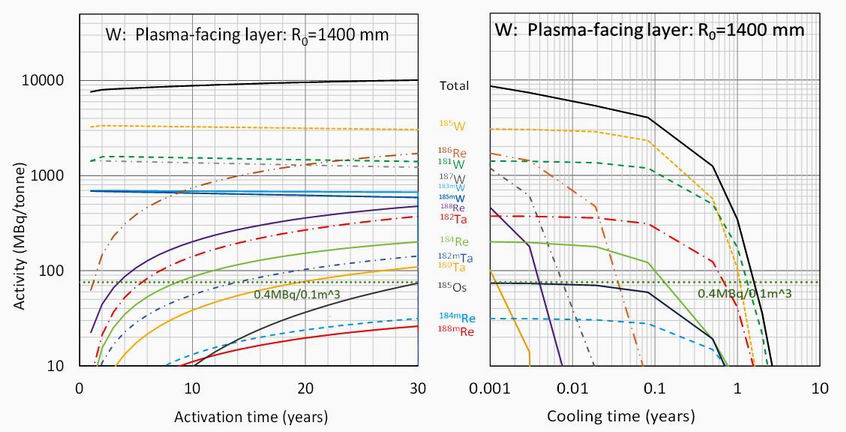
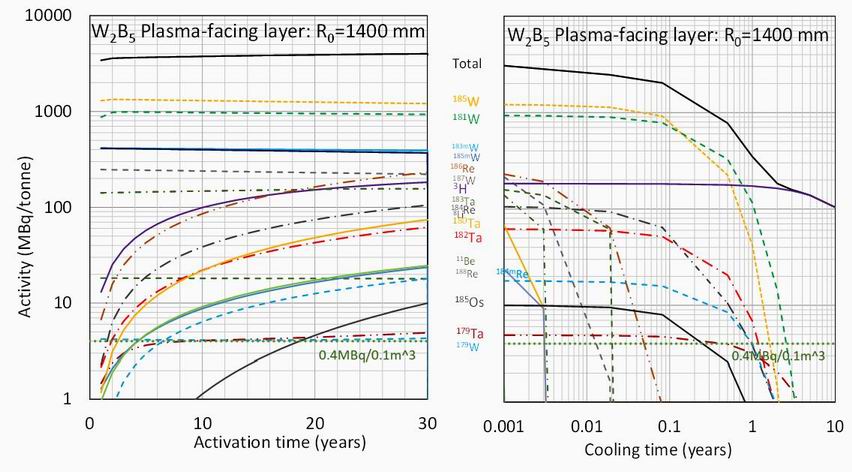
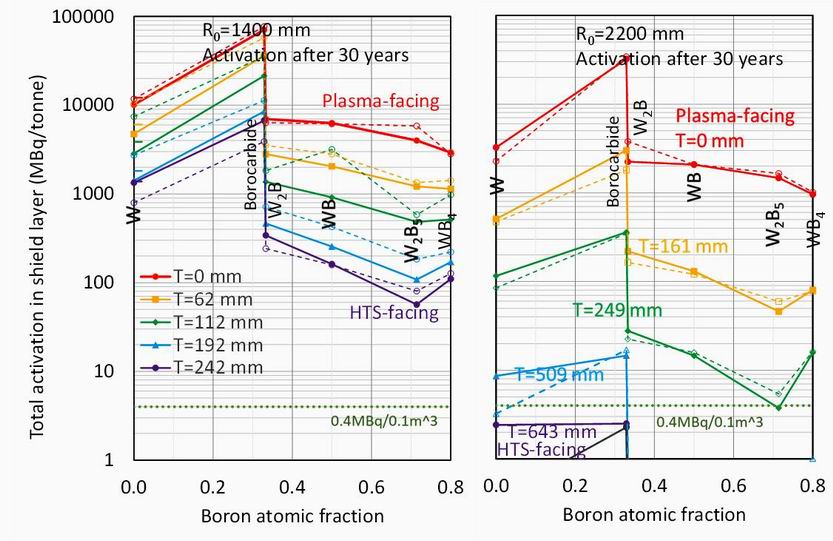
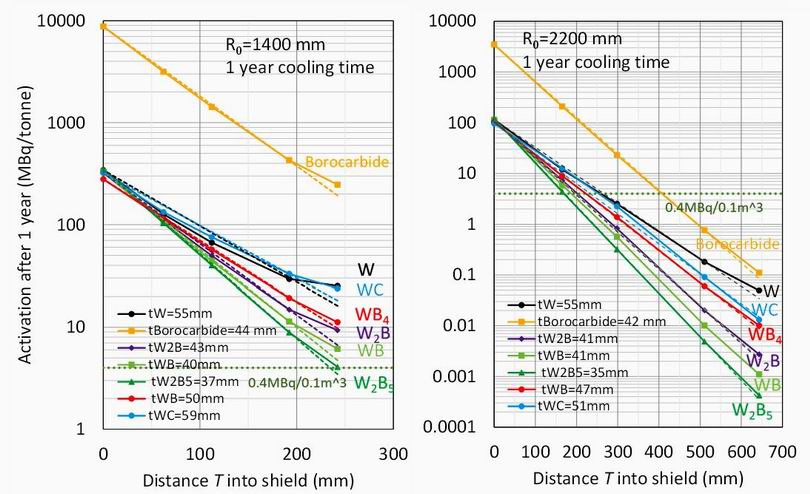
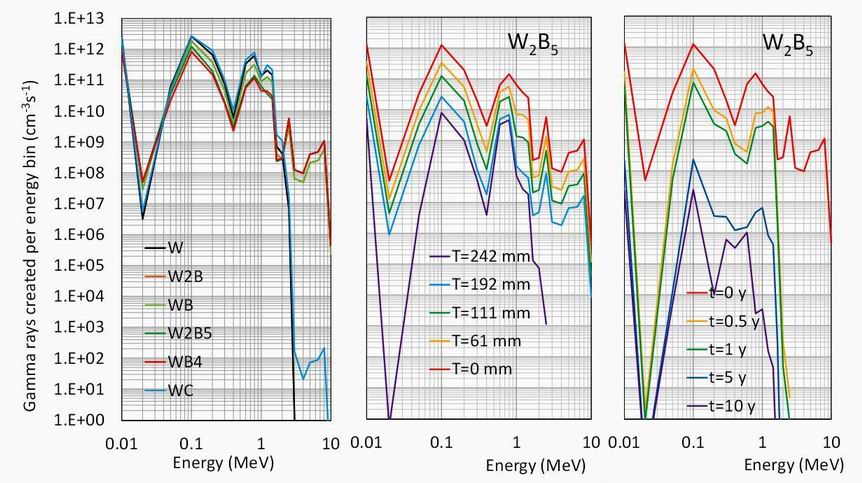
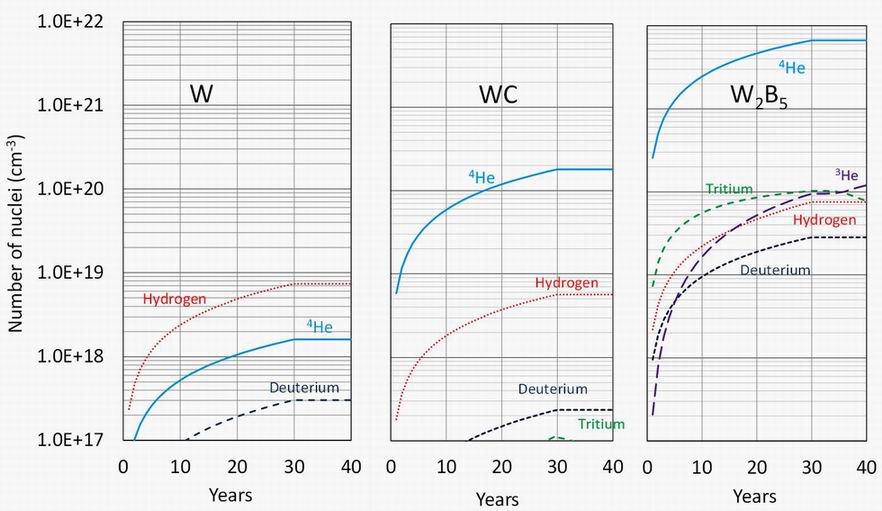
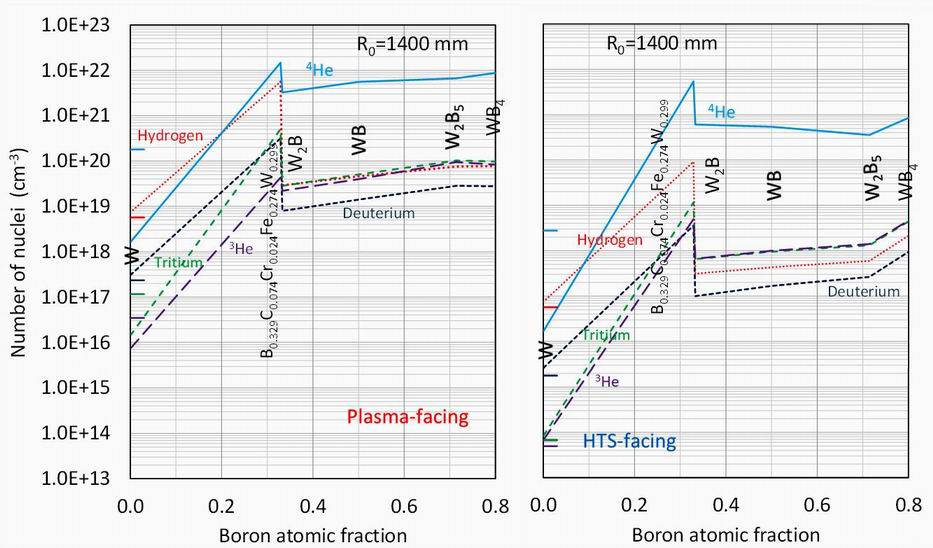
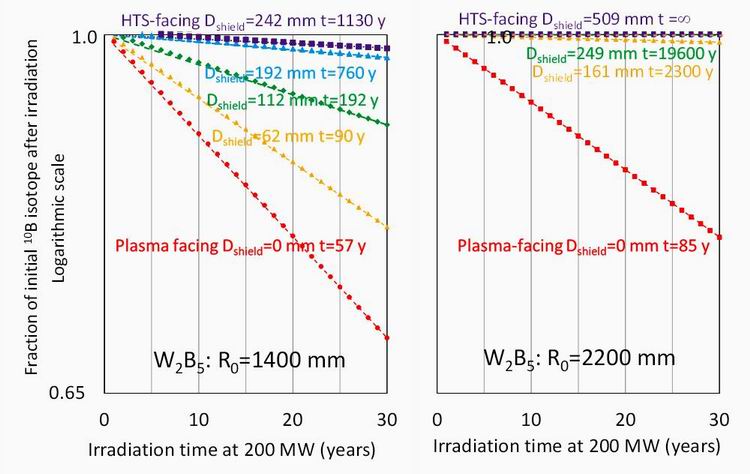
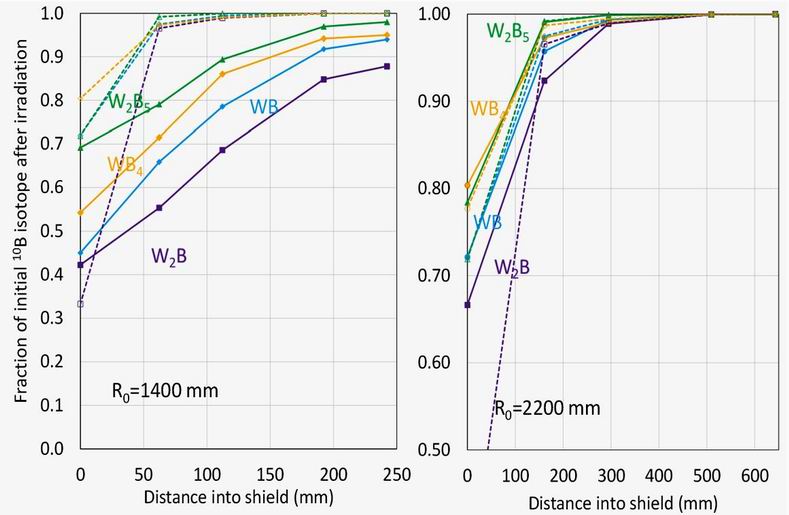
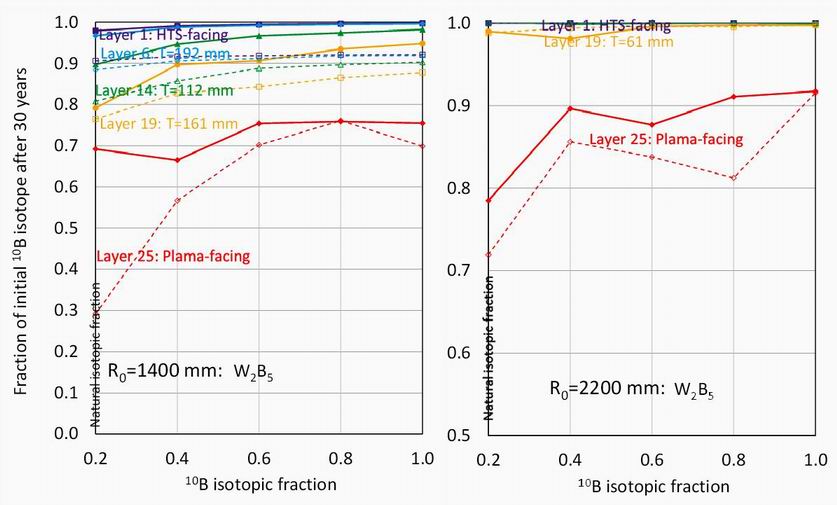

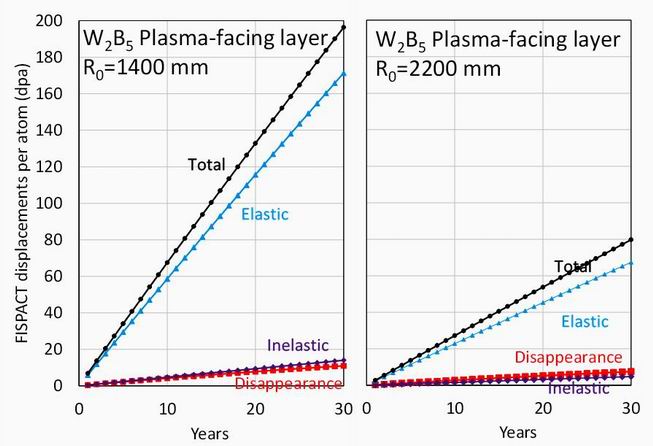
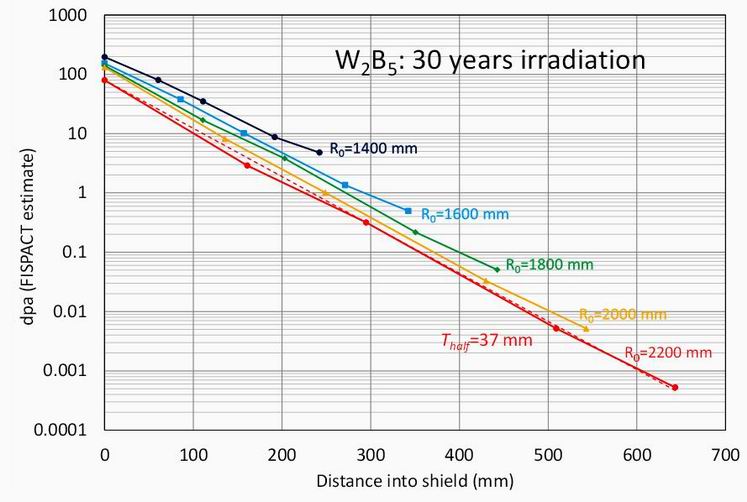

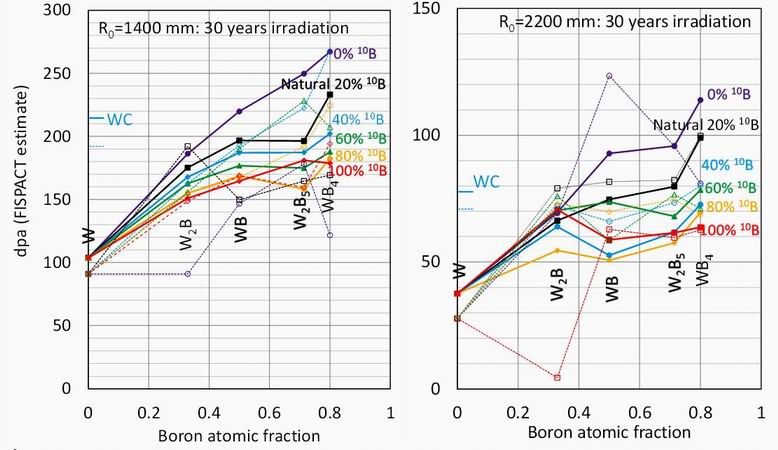
 As approved for publication by Nuclear Fusion 29/12/21: On-line publication 31/01/1922 Nucl.Fusion 61 086018 (12pp) (2022) https://doi.org/10.1088/1741-4326/ac4866
As approved for publication by Nuclear Fusion 29/12/21: On-line publication 31/01/1922 Nucl.Fusion 61 086018 (12pp) (2022) https://doi.org/10.1088/1741-4326/ac4866